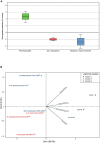Deciphering Genomes: Genetic Signatures of Plant-Associated Micromonospora
- PMID: 35401599
- PMCID: PMC8990736
- DOI: 10.3389/fpls.2022.872356
Deciphering Genomes: Genetic Signatures of Plant-Associated Micromonospora
Abstract
Understanding plant-microbe interactions with the possibility to modulate the plant's microbiome is essential to design new strategies for a more productive and sustainable agriculture and to maintain natural ecosystems. Therefore, a key question is how to design bacterial consortia that will yield the desired host phenotype. This work was designed to identify the potential genomic features involved in the interaction between Micromonospora and known host plants. Seventy-four Micromonospora genomes representing diverse environments were used to generate a database of all potentially plant-related genes using a novel bioinformatic pipeline that combined screening for microbial-plant related features and comparison with available plant host proteomes. The strains were recovered in three clusters, highly correlated with several environments: plant-associated, soil/rhizosphere, and marine/mangrove. Irrespective of their isolation source, most strains shared genes coding for commonly screened plant growth promotion features, while differences in plant colonization related traits were observed. When Arabidopsis thaliana plants were inoculated with representative Micromonospora strains selected from the three environments, significant differences were in found in the corresponding plant phenotypes. Our results indicate that the identified genomic signatures help select those strains with the highest probability to successfully colonize the plant and contribute to its wellbeing. These results also suggest that plant growth promotion markers alone are not good indicators for the selection of beneficial bacteria to improve crop production and the recovery of ecosystems.
Keywords: Micromonospora; PGP; actinobacteria; endophyte; genome; microbe-plant interaction.
Copyright © 2022 Riesco, Ortúzar, Fernández-Ábalos and Trujillo.
Conflict of interest statement
The authors declare that the research was conducted in the absence of any commercial or financial relationships that could be construed as a potential conflict of interest.
Figures






Similar articles
-
Endophytic Actinobacteria and the Interaction of Micromonospora and Nitrogen Fixing Plants.Front Microbiol. 2015 Dec 1;6:1341. doi: 10.3389/fmicb.2015.01341. eCollection 2015. Front Microbiol. 2015. PMID: 26648923 Free PMC article. Review.
-
Metabolic and Genomic Traits of Phytobeneficial Phenazine-Producing Pseudomonas spp. Are Linked to Rhizosphere Colonization in Arabidopsis thaliana and Solanum tuberosum.Appl Environ Microbiol. 2020 Feb 3;86(4):e02443-19. doi: 10.1128/AEM.02443-19. Print 2020 Feb 3. Appl Environ Microbiol. 2020. PMID: 31811040 Free PMC article.
-
Genome features of the endophytic actinobacterium Micromonospora lupini strain Lupac 08: on the process of adaptation to an endophytic life style?PLoS One. 2014 Sep 30;9(9):e108522. doi: 10.1371/journal.pone.0108522. eCollection 2014. PLoS One. 2014. PMID: 25268993 Free PMC article.
-
Micromonospora metallophores: A plant growth promotion trait useful for bacterial-assisted phytoremediation?Sci Total Environ. 2020 Oct 15;739:139850. doi: 10.1016/j.scitotenv.2020.139850. Epub 2020 Jun 1. Sci Total Environ. 2020. PMID: 32554115
-
Exploiting rhizosphere microbial cooperation for developing sustainable agriculture strategies.Environ Sci Pollut Res Int. 2018 Oct;25(30):29953-29970. doi: 10.1007/s11356-017-1152-2. Epub 2018 Jan 8. Environ Sci Pollut Res Int. 2018. PMID: 29313197 Review.
Cited by
-
Integration of Omics Approaches Enhances the Impact of Scientific Research in Environmental Applications.Int J Environ Res Public Health. 2022 Jul 19;19(14):8758. doi: 10.3390/ijerph19148758. Int J Environ Res Public Health. 2022. PMID: 35886610 Free PMC article.
-
Comparative genomics reveals insight into the phylogeny and habitat adaptation of novel Amycolatopsis species, an endophytic actinomycete associated with scab lesions on potato tubers.Front Plant Sci. 2024 Mar 27;15:1346574. doi: 10.3389/fpls.2024.1346574. eCollection 2024. Front Plant Sci. 2024. PMID: 38601305 Free PMC article.
-
Karakum desert: a unique source of cultivable novel and rare actinomycetes with a remarkable biosynthetic potential.World J Microbiol Biotechnol. 2025 Jun 24;41(7):202. doi: 10.1007/s11274-025-04399-3. World J Microbiol Biotechnol. 2025. PMID: 40553312 Free PMC article.
References
LinkOut - more resources
Full Text Sources
Molecular Biology Databases
Miscellaneous

